
Alberobello is a small town and comune of the Metropolitan City of Bari, Apulia, southern Italy. It has 10,237 inhabitants (2022) and is famous for its unique trullo buildings. The trulli of Alberobello have been designated as a UNESCO World Heritage Site since 1996. Alberobello is one of I Borghi più belli d'Italia.

A motte-and-bailey castle is a European fortification with a wooden or stone keep situated on a raised area of ground called a motte, accompanied by a walled courtyard, or bailey, surrounded by a protective ditch and palisade. Relatively easy to build with unskilled labour, but still militarily formidable, these castles were built across northern Europe from the 10th century onwards, spreading from Normandy and Anjou in France, into the Holy Roman Empire, as well as the Low Countries it controlled, in the 11th century, when these castles were popularized in the area that became the Netherlands. The Normans introduced the design into England and Wales. Motte-and-bailey castles were adopted in Scotland, Ireland, and Denmark in the 12th and 13th centuries. By the end of the 13th century, the design was largely superseded by alternative forms of fortification, but the earthworks remain a prominent feature in many countries.
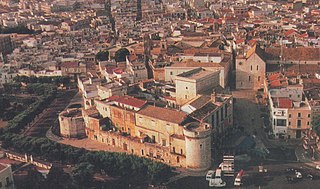
Conversano is an ancient town and comune in the Metropolitan City of Bari, Apulia, south-eastern Italy. It is 30 kilometres (19 mi) southeast of Bari and 7 kilometres (4 mi) from the Adriatic coast, at 219 metres (719 ft) above sea level.

Swansea Castle is located in the city centre of Swansea, Wales, UK. It was founded by Henry de Beaumont in 1107 as the caput of the lordship of Gower. The castle is now ruined and only two blocks remain, though the site has been improved in the 2010s for use as a public space.

Bitonto is a comune in the Metropolitan City of Bari, in the Italian region of Apulia. It lies to the west of Bari. It is nicknamed the "City of Olives", due to the numerous olive groves surrounding the city.

Teggiano, formerly Diano, is a town and comune (municipality) in the province of Salerno, Campania, Italy. It is situated on an isolated eminence above the upper part of the valley to which it gives the name of Vallo di Diano.
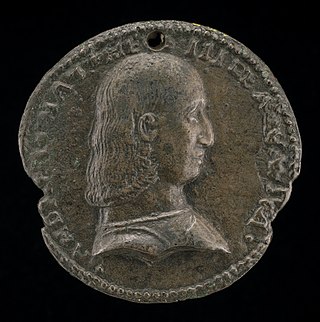
Andrea Matteo Acquaviva, 8th Duke of Atri (1458–1529) was an Italian nobleman and condottiero from the Kingdom of Naples. Born in Conversano, Puglia, he was the second son of Duke Giulio Antonio Acquaviva and his wife Caterina Orsini del Balzo. She was a first cousin of Queen Isabella, the wife of King Ferrante of Naples.
Encastellation is the process whereby the feudal kingdoms of Europe became dotted with castles, from which local lords could dominate the countryside of their fiefs and their neighbours', and from which kings could command even the far-off corners of their realms. The ubiquity of the castle is iconic of the Middle Ages.

Irsina, until 1895 called Montepeloso, is a town, comune (municipality) and former Latin bishopric in the province of Matera, in the Southern Italian region of Basilicata. It is one of I Borghi più belli d'Italia.

Acquaviva delle Fonti is a town and comune of 20,446 inhabitants, in the Metropolitan City of Bari, in Apulia, Italy. Acquaviva is famous for its characteristic red onions, which have been awarded the DOP mark. The main monuments are the Palazzo de Mari, the Co-Cathedral of Sant'Eustachio and the ancient village. The town is located on the Murge plateau at an elevation of 300 metres (980 ft) above sea level, and is 26 kilometres (16 mi) from the Adriatic Sea and Bari, which is the biggest city of the region. The Ionian Sea is more than 45 kilometres (28 mi) to the south.

Casamassima is a town and comune of 19,786 inhabitants in the Metropolitan City of Bari, in Apulia, southern Italy. Is also called "The Blue Town". The town is located inland from the Italian coastline, thrives and is built on agriculture, primarily that of wine, olives and almond production. Founded around the seventh and eighth centuries, the village started as a Roman encampment, according to legend.
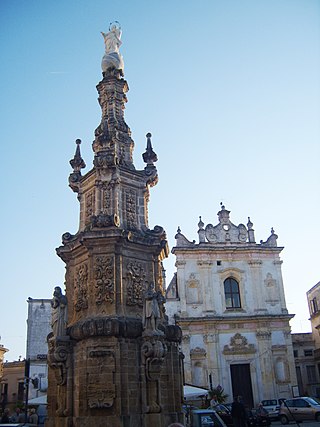
Nardò is a town and comune in the southern Italian region of Apulia, in the Province of Lecce.

Giovanni Vincenzo Acquaviva d'Aragona was a Cardinal of the Roman Catholic Church. He became bishop of Melfi and Rapolla in 1537.

Paolo Domenico Finoglia, or Finoglio, was an Italian painter of the early-Baroque period, active mainly in South Italy, including Naples and towns in Apulia.

Giulio Antonio Acquaviva was an Italian nobleman and condottiere. He was 7th Duke of Atri and 1st of Teramo, Count of Conversano and San Flaviano and Lord of Padula and Roseto.

The House of Acquaviva is an aristocratic Italian family from Naples. The head of the family was Duke of Atri in the Abruzzo from the 15th century, and Count of Conversano after an Orsini family marriage in 1546, among other titles.

Solavers Castle is a castle in the municipality of Seewis im Prättigau of the Canton of Graubünden in Switzerland.
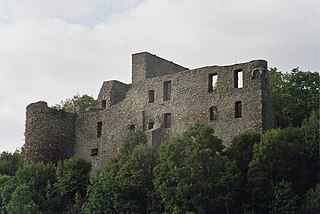
Virneburg Castle is a ruined hill castle on a slate hill, 430 m above sea level (NHN), around which the Nitzbach stream flows. It stands above the village of Virneburg in the county of Mayen-Koblenz in the German state of Rhineland-Palatinate.
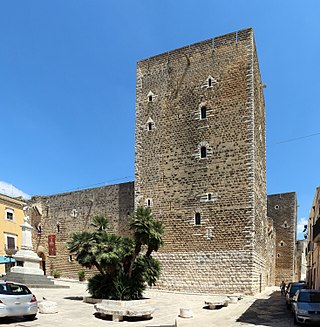
The Castello Normanno-Svevo is a Normans' castle located in the historic center of Gioia del Colle. Since December 2014, the Ministry of Cultural Heritage and Activities has managed the entire castle through the Polo Museale della Puglia, which, in December 2019, became the Direzione Regionale Musei.

Cercemaggiore Castle is located in Cercemaggiore, Italy.




















